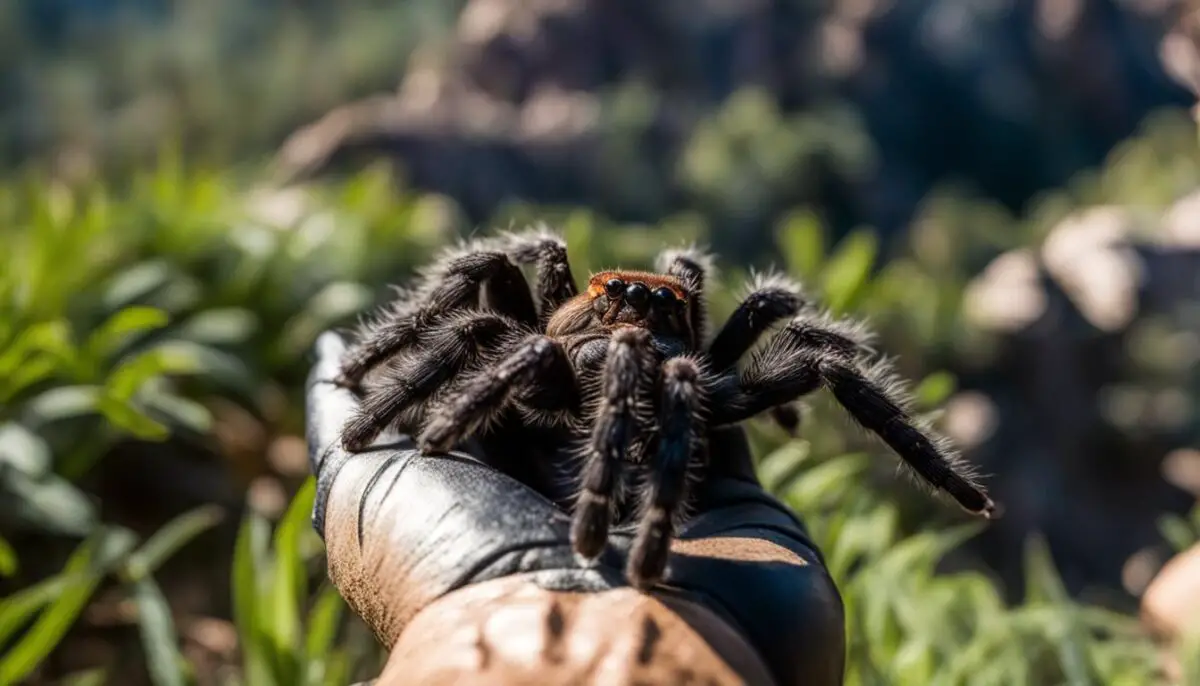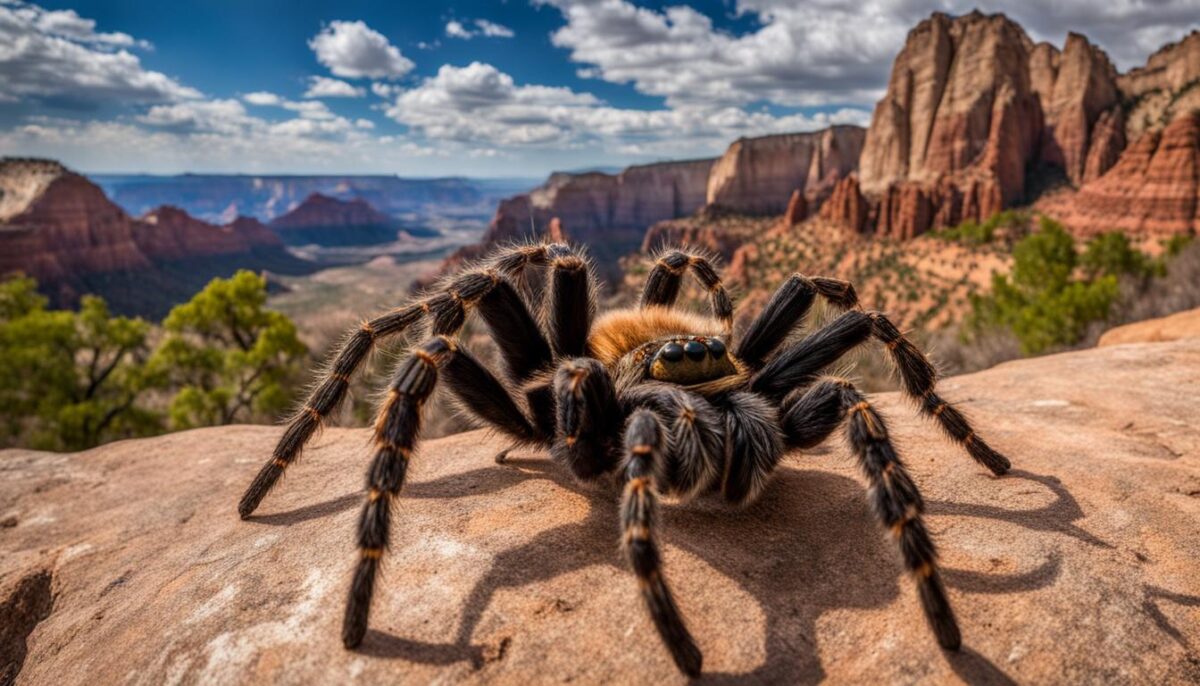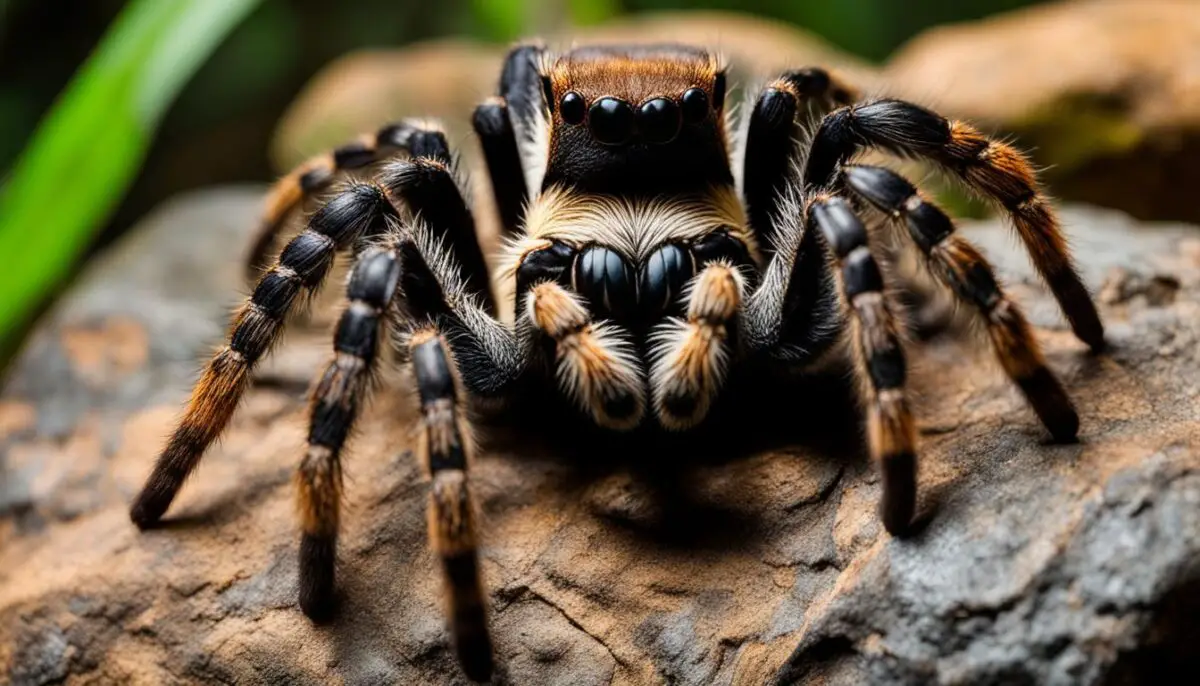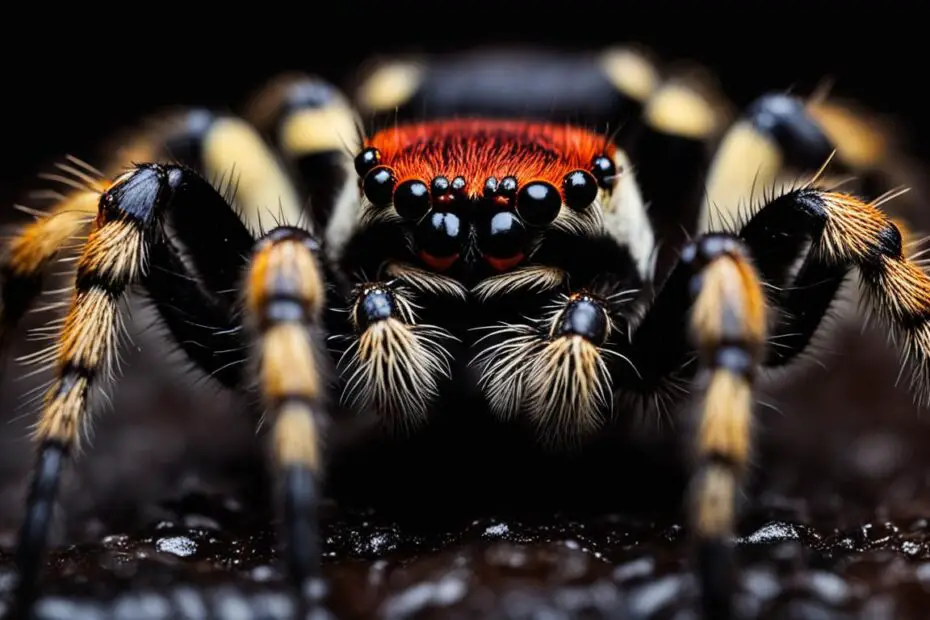Welcome to our exciting exploration of venomous tarantulas! These fascinating creatures, scientifically known as Theraphosidae, are carnivorous spiders with a venomous bite. In this article, we will delve into the world of tarantulas, shedding light on what makes certain species venomous and how they play a vital role in their ecosystems.
Key Takeaways:
- Tarantulas are large spiders with low toxicity venom.
- They primarily prey on insects but can also target larger animals.
- Tarantulas have a cephalothorax with eyes, fangs, and legs, and an abdomen with vital organs.
- Some tarantula species are venomous, while others are considered non-venomous.
- Proper identification and responsible handling of tarantulas are essential.
What Tarantulas Are Venomous:
The Anatomy of Tarantulas
Tarantulas, fascinating creatures belonging to the Theraphosidae family, have a unique anatomy. Let’s take a closer look at their intriguing physical features and understand how they function.
1. Cephalothorax and Abdomen
Tarantulas have a distinct body structure consisting of a cephalothorax and an abdomen. The cephalothorax, also known as the head and thorax region, houses their vital organs, sensory appendages, eyes, fangs, and legs. On the other hand, the abdomen contains their silk-producing glands and internal organs.
2. Fangs and Venom Glands
One of the most striking features of tarantulas is their formidable fangs. These sharp, chitinous structures are connected to venom glands located within the cephalothorax. The venom glands produce a potent venom that tarantulas use to subdue their prey. When hunting, tarantulas inject venom into their victims through their hollow fangs, paralyzing them and making them easier to consume.
3. Legs and Mobility
Tarantulas possess four pairs of legs, giving them a total of eight legs. These legs are essential for their mobility, allowing them to move swiftly and gracefully. Tarantulas also utilize their legs to capture prey, using them to grab and hold their victims before delivering a venomous bite.
4. Silk-Producing Glands
In their abdomen, tarantulas have specialized silk-producing glands. These glands enable them to produce silk, which serves various purposes in their lives. Tarantulas use silk to construct their burrows, line their nests, create egg sacs to protect their offspring, and even as a means of communication through vibrations.
In summary, tarantulas possess a fascinating and intricate anatomy. From their cephalothorax housing their eyes, legs, and fangs, to their abdomen with silk-producing glands, each part plays a crucial role in their survival and behavior.
Venomous Tarantulas
Tarantulas, like the Indian Ornamental Tarantula, Brazilian Wandering Spider, and King Baboon Tarantula, are among the venomous species of tarantulas found in different parts of the world. Their venom primarily contains neurotoxins that target the nervous systems of their prey, leading to paralysis. While venomous tarantula bites can be painful, they are not typically life-threatening to humans. what tarantulas are venomous
Venom composition in tarantulas is a fascinating area of study. These venomous species have evolved sophisticated venom delivery systems, characterized by hollow fangs connected to venom glands. When hunting, they inject venom into their prey, which immobilizes it and facilitates the tarantula’s feeding process.
“The venom of tarantulas is an intriguing concoction of neurotoxic compounds that paralyze their prey. It is a remarkable example of nature’s adaptation and the intricate arms race between predator and prey,” says Dr. Samantha Miller, a renowned arachnologist.
While the venom of venomous tarantulas can be harmful to their prey, it is important to note that tarantula bites are relatively rare. These spiders typically bite as a last resort when they feel threatened or cornered. In general, tarantulas prefer to use their venom for subduing prey rather than as a defense mechanism against humans. poisonous tarantulas
Table 1: Examples of Venomous Tarantula Species
| Tarantula Species | Scientific Name | Region |
|---|---|---|
| Indian Ornamental Tarantula | Poecilotheria regalis | India and Sri Lanka |
| Brazilian Wandering Spider | Phoneutria spp. | South America |
| King Baboon Tarantula | Pelinobius muticus | Central and East Africa |

These examples of venomous tarantulas highlight the diverse range of species and their distribution across different regions. While venomous tarantulas may inspire fascination and a degree of caution, it is important to approach them with respect and responsible behavior to ensure both human safety and the well-being of these intriguing creatures.
Non-Venomous Tarantulas
Tarantulas are fascinating creatures that come in a wide variety of species. While some tarantulas are classified as venomous, the majority of them are considered non-venomous. Non-venomous tarantulas have a mild venom or are virtually venomless, making them relatively harmless to humans. deadliest tarantulas
One popular example of a non-venomous tarantula is the Chilean Rose Tarantula (Grammostola rosea). This species is often kept as a pet due to its docile nature and beautiful appearance. The Chilean Rose Tarantula has a reputation for being a great beginner species for tarantula enthusiasts.
Another noteworthy non-venomous tarantula species is the Mexican Redknee Tarantula (Brachypelma smithi). This tarantula is known for its striking red and black coloration, making it a sought-after species among collectors. The Mexican Redknee Tarantula is relatively docile and is a popular choice for tarantula enthusiasts. toxic tarantulas
Here is a table summarizing some examples of non-venomous tarantula species:
| Tarantula Species | Scientific Name | Origin | Unique Characteristics |
|---|---|---|---|
| Chilean Rose Tarantula | Grammostola rosea | Chile | Docile nature, beautiful appearance |
| Mexican Redknee Tarantula | Brachypelma smithi | Mexico | Striking red and black coloration |
| Costa Rican Zebra Tarantula | Aphonopelma seemanni | Costa Rica | Zebra-like stripes, relatively calm temperament |
| Brazilian Black Tarantula | Grammostola pulchra | Brazil | Jet-black color, slow-moving and docile |
These non-venomous tarantulas may still possess fangs and can deliver a bite, which can cause localized pain and swelling. However, it is important to note that their bites are not typically dangerous to humans and usually do not require medical attention.
Understanding the difference between venomous and non-venomous tarantulas is essential for safely interacting with these fascinating creatures. By appreciating the diversity and unique characteristics of non-venomous tarantula species, we can gain a deeper appreciation for the intricate beauty of the natural world.
The Importance of Proper Identification
Proper identification of tarantula species is essential for various reasons. It enables pet owners to provide appropriate care and handling techniques, ensuring the well-being of both the tarantula and the owner. Additionally, accurate identification plays a vital role in conservation efforts, as different tarantula species have distinct ecological roles and habitat requirements. By correctly identifying tarantulas, we can promote responsible behavior and contribute to the preservation of these remarkable creatures.
Distinguishing between venomous and non-venomous tarantulas is a critical aspect of proper identification. While most tarantula bites are not dangerous to humans, venomous tarantulas can pose a risk if mishandled. Understanding venomous species allows individuals to take necessary precautions and seek appropriate medical attention if necessary. Responsible handling practices, such as using soft brushes or hands when interacting with tarantulas, further minimize the chances of bites or injuries. dangerous tarantula species
Conservation is another compelling reason for accurate tarantula identification. By knowing which species inhabit certain regions and their specific habitat requirements, conservationists can develop targeted strategies for protecting these unique creatures and their ecosystems. Tarantulas play vital roles in natural ecosystems, such as controlling pest populations and serving as prey for other wildlife. Through responsible identification and conservation efforts, we can ensure the long-term survival of tarantulas and preserve the delicate balance of our natural world.
Table: Comparing Venomous and Non-Venomous Tarantulas
| Tarantula Species | Venomous | Bite Effects |
|---|---|---|
| Indian Ornamental Tarantula (Poecilotheria regalis) | Yes | Localized pain, swelling |
| Brazilian Wandering Spider (Phoneutria spp.) | Yes | Painful bite, potential systemic effects |
| King Baboon Tarantula (Pelinobius muticus) | Yes | Localized pain, swelling |
| Chilean Rose Tarantula (Grammostola rosea) | No | Mild pain, localized swelling |
| Mexican Redknee Tarantula (Brachypelma smithi) | No | Mild pain, localized swelling |
Table: Comparing venomous and non-venomous tarantula species. Venomous tarantulas can have more severe bite effects, such as painful bites, swelling, and potential systemic effects. Non-venomous tarantulas typically have milder bite effects, causing localized pain and swelling. venomous spiders
Handling Tarantulas
Whether you have a pet tarantula or encounter one in the wild, handling them requires caution and respect. Tarantulas are delicate creatures, and their well-being, as well as your safety, should be a top priority.
When handling a pet tarantula, remember to be patient and gentle. Use soft brushes or your hands to interact with them, avoiding sudden movements or squeezing. It’s important to create a calm and controlled environment to ensure the tarantula feels safe and secure.
In the wild, it’s best to observe tarantulas from a safe distance. Using binoculars or telephoto lenses allows you to appreciate their beauty without disturbing their natural habitat. Respect their space and avoid touching or picking them up, as this can stress the tarantula and potentially harm you if they feel threatened.
Remember, tarantulas are fascinating creatures that play an important role in our ecosystem. By handling them responsibly and promoting their conservation, we can ensure their well-being and continue to marvel at their remarkable adaptations.

Avoiding Bites
- Always wash your hands before and after handling a tarantula.
- Avoid sudden movements or loud noises that may startle the tarantula.
- Wear protective gloves if necessary, but be cautious as they may reduce your dexterity and increase the risk of accidental harm.
- Do not handle a tarantula if you feel uncomfortable or unsure. Seek assistance from someone experienced in tarantula handling.
Important Considerations for Pet Tarantulas
If you have a pet tarantula, it’s important to provide them with a suitable enclosure and proper care. Research their specific species to understand their habitat requirements, diet, and other needs. Consult a veterinarian who specializes in exotic pets for professional advice and regular check-ups.
| Aspect | Considerations |
|---|---|
| Housing | Ensure the enclosure is escape-proof, adequately ventilated, and provides enough space for the tarantula to move around comfortably. |
| Substrate | Choose a suitable substrate that mimics the tarantula’s natural environment, such as coconut fiber or peat moss. |
| Temperature and Humidity | Monitor and maintain appropriate temperature and humidity levels within the enclosure, as different tarantula species have different requirements. |
| Feeding | Offer a varied diet of appropriately sized live insects, such as crickets or roaches, ensuring they are properly gut-loaded and free from pesticides. |
| Enrichment | Add hiding spots, branches, and other suitable decorations to the enclosure to provide stimulation and promote natural behavior. |
Venom and Health Considerations
When it comes to tarantulas, bites can be a concern. Understanding the potential effects of tarantula venom and knowing how to respond is essential for your safety and well-being. It’s important to note that not all tarantulas are venomous, and the severity of their venom varies.
Venomous tarantula bites can cause localized pain, swelling, and redness. If you are bitten by a venomous tarantula, it’s crucial to clean the wound with soap and water to reduce the risk of infection. Seek medical attention promptly to assess the bite’s severity and receive appropriate treatment. Symptoms may include nausea, muscle cramps, or allergic reactions such as difficulty breathing or swelling of the face and throat.
On the other hand, bites from non-venomous tarantulas are generally harmless to humans. While they may cause localized pain and swelling, these symptoms usually subside on their own. If you experience severe or persistent symptoms, it’s advisable to seek medical help to rule out any complications.
Table: Comparison of Venomous and Non-Venomous Tarantula Bites
| Aspect | Venomous Tarantula Bites | Non-Venomous Tarantula Bites |
|---|---|---|
| Symptoms | Pain, swelling, redness, nausea, muscle cramps, allergic reactions | Pain, localized swelling |
| Treatment | Clean with soap and water, seek medical attention for assessment and treatment | Clean with soap and water, monitor symptoms, seek medical help if severe or persistent symptoms occur |
| Severity | Potentially more severe, with the risk of allergic reactions or systemic effects | Generally mild, with localized effects |
Remember, tarantulas are not aggressive creatures, and they usually bite as a last resort when provoked or threatened. By approaching tarantulas with respect and caution, you can minimize the risk of bites and enjoy these fascinating arachnids from a safe distance.
The Fascinating World of Tarantulas
Tarantulas, belonging to the family Theraphosidae, are incredibly diverse creatures that have made themselves at home in various habitats around the world. These arachnids have evolved over millions of years, developing unique adaptations to survive in different ecosystems.
From the lush tropical rainforests to the harsh arid deserts, tarantulas can be found thriving in a wide range of habitats. Their ability to adapt to such diverse environments is a testament to their resilience and flexibility as a species.
One of the most fascinating aspects of tarantulas is their incredible species diversity. With hundreds of tarantula species existing today, each one has its own distinct characteristics and attributes. From the vibrant colors of the Indian Ornamental Tarantula to the sheer size of the King Baboon Tarantula, these spiders never fail to capture our imagination.
Table:
| Tarantula Species | Habitat | Characteristics |
|---|---|---|
| Indian Ornamental Tarantula | Tropical Rainforests of India and Sri Lanka | Vibrant colors and intricate patterns |
| Brazilian Wandering Spider | Rainforests of South America | Aggressive hunters and highly venomous |
| King Baboon Tarantula | Savannas and Grasslands of East Africa | Large, heavy-bodied spiders with potent venom |
“The diversity of tarantula species and their ability to adapt to various habitats is truly remarkable. These creatures have not only survived but thrived in some of the most challenging environments. It’s a testament to the resilience and adaptability of nature.” – Arachnid Expert
The fascinating world of tarantulas showcases the incredible beauty and complexity of the natural world. Each species has its own unique adaptations to suit their habitat and lifestyle, making them a captivating subject of study for scientists and arachnid enthusiasts alike.

In Conclusion
While tarantulas are not commonly associated with Zion National Park, they do play a role in its rich biodiversity. Their mysterious habits and occasional sightings add to the allure of this renowned destination. Remember to drive carefully and respect the wildlife when exploring Zion, as every encounter with these fascinating creatures is a testament to the park’s natural wonders.
Conservation and Respect
Tarantulas, with their unique characteristics and vital role in ecosystems, deserve our utmost respect and conservation efforts. By understanding their importance and practicing responsible behavior, we can contribute to their survival and the preservation of their habitats.
Conservation of tarantulas involves protecting their natural habitats, which are often threatened by deforestation, urbanization, and climate change. Preserving these habitats ensures that tarantulas have sufficient resources and suitable environments to thrive. Additionally, conservation efforts focus on raising awareness about the importance of these creatures and promoting their conservation among the general public.
“Tarantulas are fascinating creatures that play critical roles in ecosystems, contributing to pest control and serving as prey for other wildlife. By respecting tarantulas and their habitats, we can help maintain the delicate balance of nature.”
- Avoid capturing or removing tarantulas from their natural environments unless it is a necessary conservation measure.
- Support organizations and institutions that work towards tarantula conservation through donations, volunteering, or participation in awareness campaigns.
- Learn about responsible pet ownership and ensure proper care for pet tarantulas, providing them with suitable living conditions and a diet that meets their nutritional needs.
- Report any illegal wildlife trade or activities that may harm tarantulas or their habitats to the relevant authorities.
By adopting these measures and spreading knowledge about the importance of tarantulas, we can contribute to their conservation and protect these fascinating creatures for future generations to appreciate and admire.

Conclusion
Tarantulas, with their diverse species, captivate us with their unique characteristics and intriguing behaviors. Their venom is a significant aspect to consider when interacting with these fascinating creatures. Understanding the difference between venomous and non-venomous tarantulas is crucial for our safety and the conservation of these misunderstood arachnids.
Venomous tarantulas, such as the Indian Ornamental Tarantula and the Brazilian Wandering Spider, possess neurotoxic venom that paralyzes their prey. While their bites can be painful, they are usually not life-threatening to humans. On the other hand, non-venomous tarantulas, like the popular Chilean Rose Tarantula, have relatively harmless venom that may cause localized pain and swelling.
By gaining knowledge about tarantula venom and their classification as venomous or non-venomous, we can approach them with respect, understanding, and responsible behavior. Proper identification, careful handling, and appreciation of their role in ecosystems contribute to their conservation and ensure their survival for future generations to admire.
Let us continue to demystify these incredible creatures, raise awareness of their importance, and protect their habitats. Tarantulas are an integral part of our natural world, and through our efforts, we can ensure their continued existence and appreciate the unique beauty they bring to our planet.
FAQ
Are all tarantulas venomous?
No, not all tarantulas are venomous. There are both venomous and non-venomous tarantula species.
How can I identify if a tarantula is venomous or non-venomous?
Proper identification is crucial. Venomous tarantulas can be identified by their specific species, such as the Indian Ornamental Tarantula, Brazilian Wandering Spider, or King Baboon Tarantula. Non-venomous tarantulas, like the Chilean Rose Tarantula, are typically harmless to humans.
What should I do if I encounter a venomous tarantula?
If you encounter a venomous tarantula, it is recommended to observe it from a safe distance and avoid any close contact. Tarantulas generally try to avoid confrontation and will only bite if they feel threatened.
What should I do if I get bitten by a venomous tarantula?
If you get bitten by a venomous tarantula, clean the affected area with soap and water and seek immediate medical attention. While tarantula bites are painful, they are typically not life-threatening to humans.
Are non-venomous tarantula bites dangerous?
Non-venomous tarantula bites can cause localized pain and swelling, but they are generally not dangerous to humans. However, if you experience severe symptoms or an allergic reaction, it is important to seek medical help.
How should I handle a pet tarantula?
When handling a pet tarantula, it is important to approach them with patience and gentleness. Soft brushes or hands can be used to handle them carefully. It is recommended to research proper handling techniques specific to your tarantula species.
What should I do if I see a tarantula in the wild?
When encountering a tarantula in the wild, it is best to observe them from a safe distance using binoculars or telephoto lenses. Avoid approaching or disturbing them, and respect their natural habitat.
Are tarantulas commonly found in Zion National Park?
Tarantulas are rarely seen in Zion National Park. They are primarily nocturnal creatures that spend most of their time in underground burrows. Sightings are more common during late summer and fall when male tarantulas are searching for mates.
How can I contribute to tarantula conservation?
Respecting tarantulas and their habitats is crucial for their conservation. By practicing responsible behavior in their presence, such as avoiding unnecessary harm and protecting their habitats, you can contribute to their survival for future generations to appreciate and admire.
What is the importance of proper tarantula identification?
Proper tarantula identification is essential for pet owners and those encountering tarantulas in the wild. Misidentifying tarantulas can lead to unnecessary fear and potential harm. Accurate identification helps ensure appropriate care and conservation of these fascinating creatures.
Why are tarantulas important for ecosystems?
Tarantulas play important roles in ecosystems by controlling pest populations and serving as prey for other wildlife. Their presence contributes to the delicate balance of nature and is crucial for maintaining a healthy ecosystem.


Have you ever thought about adding a little bit more than just your articles? I mean, what you say is valuable and everything. Nevertheless think of if you added some great visuals or videos to give your posts more, “pop”! Your content is excellent but with pics and clips, this site could undeniably be one of the very best in its field. Amazing blog!
You have mentioned very interesting details! ps decent website.Raise your business